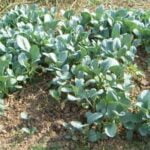Cement is often used in construction, but is cement safe for vegetable gardens? The use of safe materials in vegetable gardens is crucial for maintaining the health and vitality of plants. In this article, we will explore the topic of using cement in vegetable gardens and discuss the potential benefits, risks, and best practices associated with its use.
When it comes to creating raised beds or garden borders, cement offers durability and stability, which can help maintain the structure and layout of a vegetable garden. However, there are also potential hazards to consider, such as chemical leaching and soil contamination. These risks highlight the need to carefully evaluate whether cement is a suitable material for use in vegetable gardens.
As we delve into this topic, we will also review research and studies on the safety of using cement in vegetable gardens, providing evidence-based information on its potential effects on plants and soil. Additionally, we will explore alternative materials that can be used in place of cement for garden construction, as well as provide tips for testing soil and cement compatibility before use.
By examining these factors, we can better understand the implications of using cement in vegetable gardens and make informed decisions about our gardening practices.
Benefits of Using Cement in Vegetable Gardens
Cement has long been used in vegetable gardens for its numerous benefits. One of the primary advantages of using cement in garden construction is its durability. When properly mixed and cured, cement can withstand various weather conditions, making it an ideal material for raised beds or garden borders. This stability can help maintain the structure and layout of a vegetable garden, providing a long-lasting framework for plants to thrive.
In addition to durability, cement also offers stability for raised beds and garden borders. The use of cement can create a reliable barrier that helps prevent soil erosion and minimizes the risk of damage from pests or other environmental factors. This can be particularly beneficial in areas prone to heavy rainfall or strong winds, where traditional garden materials may struggle to maintain their integrity over time.
Moreover, using cement in vegetable gardens can contribute to easier maintenance and upkeep. Unlike some natural materials that may decay or degrade over time, properly constructed cement structures require minimal maintenance and provide long-term support for the plants within the garden. This ease of maintenance can be advantageous for gardeners looking to establish a low-maintenance gardening environment while still nurturing healthy crops.
| Benefits | Considerations |
|---|---|
| Durability | Proper mixing and curing required |
| Stability | Prevents soil erosion and damage from pests |
| Ease of Maintenance | Long-term support with minimal upkeep |
Risks and Dangers of Using Cement in Vegetable Gardens
When considering the use of cement in vegetable gardens, it is essential to be aware of the potential risks and dangers associated with this material. One of the primary concerns with using cement in garden construction is the possibility of chemical leaching and soil contamination.
As cement breaks down over time, it can release various compounds and minerals into the soil, which may have adverse effects on plant growth and health. These contaminants can disrupt the natural balance of nutrients in the soil and impact the overall well-being of vegetables and other plants.
Additionally, the use of cement in vegetable gardens can also affect the pH levels of the soil. The alkaline nature of cement can lead to an increase in soil pH, which may not be suitable for certain types of plants. High pH levels can hinder nutrient absorption by plants, potentially leading to deficiencies and stunted growth. Therefore, it is crucial for gardeners to consider these factors before incorporating cement into their garden designs.
Furthermore, studies have shown that some components present in cement, such as lime, aluminum oxide, and iron oxide, can have detrimental effects on plant roots and microbial activity in the soil. This highlights the importance of understanding the potential risks associated with using cement in vegetable gardens and taking proactive measures to mitigate these issues.
| Risks Associated With Cement | Impact on Soil |
|---|---|
| Chemical leaching | Disruption of nutrient balance |
| pH level alteration | Reduced nutrient absorption by plants |
| Harmful components like lime and aluminum oxide | Negative effects on plant roots and microbial activity |
Research and Studies on Cement in Vegetable Gardens
When considering the use of cement in vegetable gardens, it is important to review existing research and studies on this subject. Understanding the potential effects of cement on plants and soil can help make informed decisions about garden construction materials. Several studies have been conducted to assess the safety and impact of using cement in vegetable gardens, providing valuable insights for gardeners.
Research has shown that one potential risk of using cement in vegetable gardens is the leaching of chemicals into the soil. Cement contains compounds such as lime, calcium oxide, and silica that can leach into the surrounding soil over time.
These chemical components may alter the pH levels of the soil, affecting the growth and health of plants. Additionally, some studies have indicated that prolonged exposure to high levels of lime from cement can lead to nutrient imbalances in the soil, impacting plant nutrient absorption.
On the other hand, research has also highlighted that properly cured and sealed cement structures may pose minimal risk to vegetable gardens. When concrete or mortar is fully cured, studies have found limited leaching of harmful substances into the soil. Furthermore, well-maintained cement structures can provide a durable and stable foundation for raised beds or garden borders, contributing to the overall structure and layout of a vegetable garden.
Best Practices for Using Cement in Vegetable Gardens
When using cement in vegetable gardens, it is essential to follow best practices to ensure the safety of the plants and soil. This section will provide guidelines for utilizing cement in vegetable gardens safely, as well as tips for minimizing potential risks associated with its use.
Choose Non-Toxic Cement
When selecting cement for your vegetable garden construction, opt for non-toxic or low-alkalinity cement products. These types of cement are less likely to leach harmful chemicals into the soil, reducing the risk of contamination. Look for eco-friendly alternatives that are specifically designed for use in organic gardening and are free from harmful additives.
Use a Protective Coating
To further prevent chemical leaching from the cement into the soil, consider applying a protective coating to the surfaces that will come into direct contact with the garden bed or soil. Sealants or coatings made specifically for this purpose can help create a barrier between the cement and the surrounding environment, minimizing any potential negative impacts.
Provide Adequate Curing Time
After constructing garden structures using cement, allow adequate curing time before introducing plants into the area. This can help ensure that any residual chemicals in the cement have been thoroughly neutralized or washed away, reducing the risk of harm to your vegetables. Follow the manufacturer’s recommendations for curing time to achieve optimal safety.
By following these best practices when using cement in vegetable gardens, gardeners can minimize potential risks and create a safe environment for their plants to thrive. Additionally, staying informed about alternative materials and testing soil and cement compatibility can further aid in making informed decisions about garden construction methods.
Alternative Materials to Cement for Vegetable Gardens
When considering materials for vegetable garden construction, cement is often a popular choice due to its durability and stability. However, there are alternative materials that can be used in place of cement for building raised beds, garden borders, and other garden structures. These alternatives offer their own unique benefits and drawbacks, providing gardeners with options to consider based on their specific needs and preferences.
Natural Stone
One alternative to using cement in vegetable gardens is natural stone. Natural stone offers a visually appealing and long-lasting option for garden construction. It can provide a more rustic and organic look to the garden while also offering durability similar to that of cement. Additionally, natural stone is resistant to weathering and does not pose the same risks of chemical leaching as cement.
However, it’s important to note that natural stone may be more expensive than cement and can be heavier to work with during the construction process. Careful consideration should also be given to the type of natural stone used, as some varieties may contain minerals or elements that could impact the soil chemistry.
Untreated Wood
Another alternative material for vegetable gardens is untreated wood. Untreated wood, such as cedar or redwood, can be a sustainable and environmentally friendly option for building garden structures. It provides a natural aesthetic that blends well with garden landscapes while also offering ease of customization for various shapes and sizes.
However, untreated wood may have a shorter lifespan compared to cement or natural stone due to potential decay from moisture and pests. Gardeners should also ensure they are using non-toxic untreated wood varieties to avoid any chemical leaching into the soil.
Recycled Plastic
Recycled plastic materials present another eco-friendly alternative for vegetable garden construction. These materials are lightweight, easy to assemble, and offer resistance to rotting, pests, and weathering. Using recycled plastic supports sustainability efforts by repurposing plastic waste into functional garden structures.
While recycled plastic offers longevity and low maintenance requirements, some individuals may have concerns about the environmental impact of using plastic in their gardens. They may also prefer a more natural aesthetic over plastic-based materials.
Tips for Testing Soil and Cement Compatibility
When considering using cement in vegetable gardens, it is crucial to ensure that the soil and cement are compatible to prevent any potential risks or hazards. Here are some tips for testing the compatibility between soil and cement:
1. Conduct a pH test: Before incorporating cement into the garden, it is essential to test the pH levels of the soil. Cement can alter the pH of the soil, affecting nutrient availability for plants. Use a pH testing kit to determine the acidity or alkalinity of the soil.
2. Perform a leaching test: To assess whether cement will leach harmful chemicals into the soil, conduct a leaching test. This involves placing a small amount of wet cement in contact with the soil and observing any changes in color or texture over time.
3. Consider soil type: Different types of soil may react differently to cement. Sandy soils, for example, may be more prone to leaching and chemical reactions with cement compared to clay soils. Understanding the composition of your soil can help evaluate its compatibility with cement.
By following these tips and conducting thorough tests, gardeners can make informed decisions about using cement in their vegetable gardens while minimizing potential risks to plant health and environmental safety. It is important to carefully consider these factors before proceeding with any construction involving cement in a vegetable garden setting.
Conclusion
In conclusion, the use of cement in vegetable gardens can have both benefits and risks. While it offers durability and stability for raised beds or garden borders, there are potential hazards such as chemical leaching and soil contamination. Research and studies have provided evidence of the impact of cement on pH levels and nutrient absorption of the soil, raising concerns about its safety for vegetable gardens.
When considering whether to use cement in a vegetable garden, it is important to carefully weigh the potential risks and take appropriate precautions. This includes testing the compatibility of the soil and cement before use, as well as exploring alternative materials that may be safer for garden construction. By following best practices and guidelines for utilizing cement in vegetable gardens safely, gardeners can minimize the potential negative effects on plants and soil.
In light of the information presented, it is recommended that individuals exercise caution when using cement in their vegetable gardens. Considering the availability of alternative materials and the potential risks involved, gardeners may opt for safer options to ensure the health and sustainability of their vegetable crops. Ultimately, making an informed decision based on the specific needs of a garden is crucial for creating a safe and productive environment for growing vegetables.
Frequently Asked Questions
Is Concrete Good in a Vegetable Garden?
Concrete can be a suitable option for use in a vegetable garden, but there are some considerations to keep in mind. While it does provide a stable and durable surface for gardening activities, it may also retain heat and cause moisture to evaporate more quickly from the soil.
To counteract this, gardeners can utilize mulch or shade to help regulate temperature and moisture levels.
Is Cement Safe to Grow Food In?
Cement is generally considered safe for growing food in, as it is primarily composed of limestone, clay, shells, and silica sand – none of which pose significant risks to plant growth or human health when used as a container or structure for gardening.
However, it’s important to ensure that the cement doesn’t contain any harmful additives or contaminants that could potentially leach into the soil and affect plant growth.
Can You Grow Vegetables on Concrete?
It is possible to grow vegetables on concrete with certain modifications to address its characteristics. One common solution is using raised beds filled with soil rather than directly planting in the concrete itself.
This helps create better growing conditions by providing proper drainage, insulation from extreme temperatures, and control over the soil composition. With careful planning and maintenance, vegetables can thrive on concrete surfaces through these alternative methods.

If you’re looking to get into vegetable gardening, or are just looking for some tips on how to make your current garden better, then you’ve come to the right place! My name is Ethel and I have been gardening for years. In this blog, I’m going to share with you some of my best tips on how to create a successful vegetable garden.





